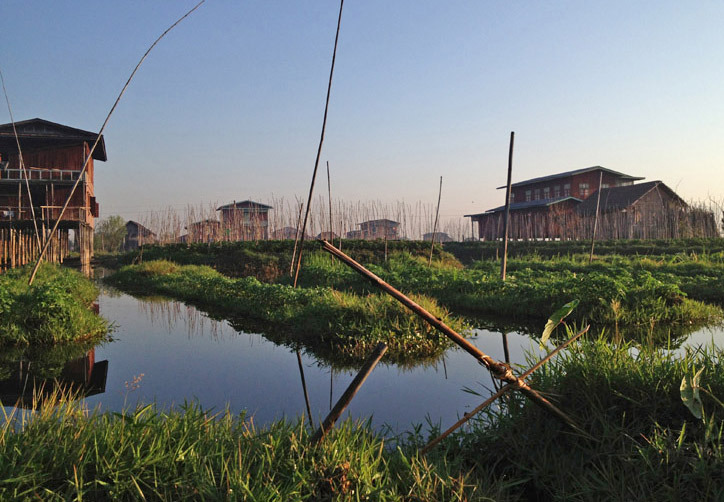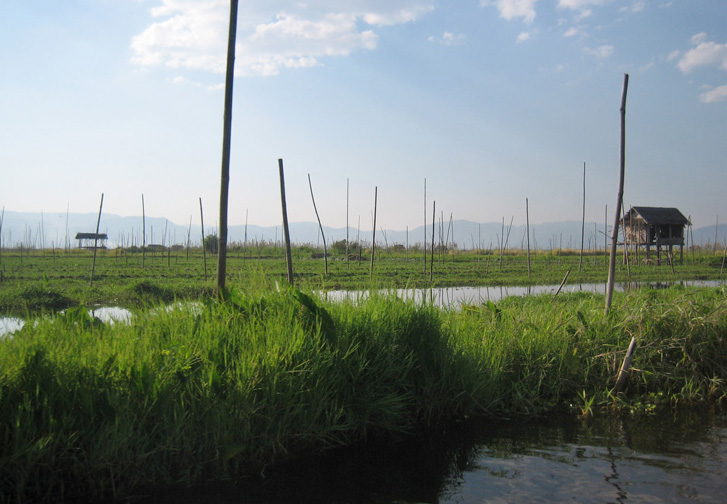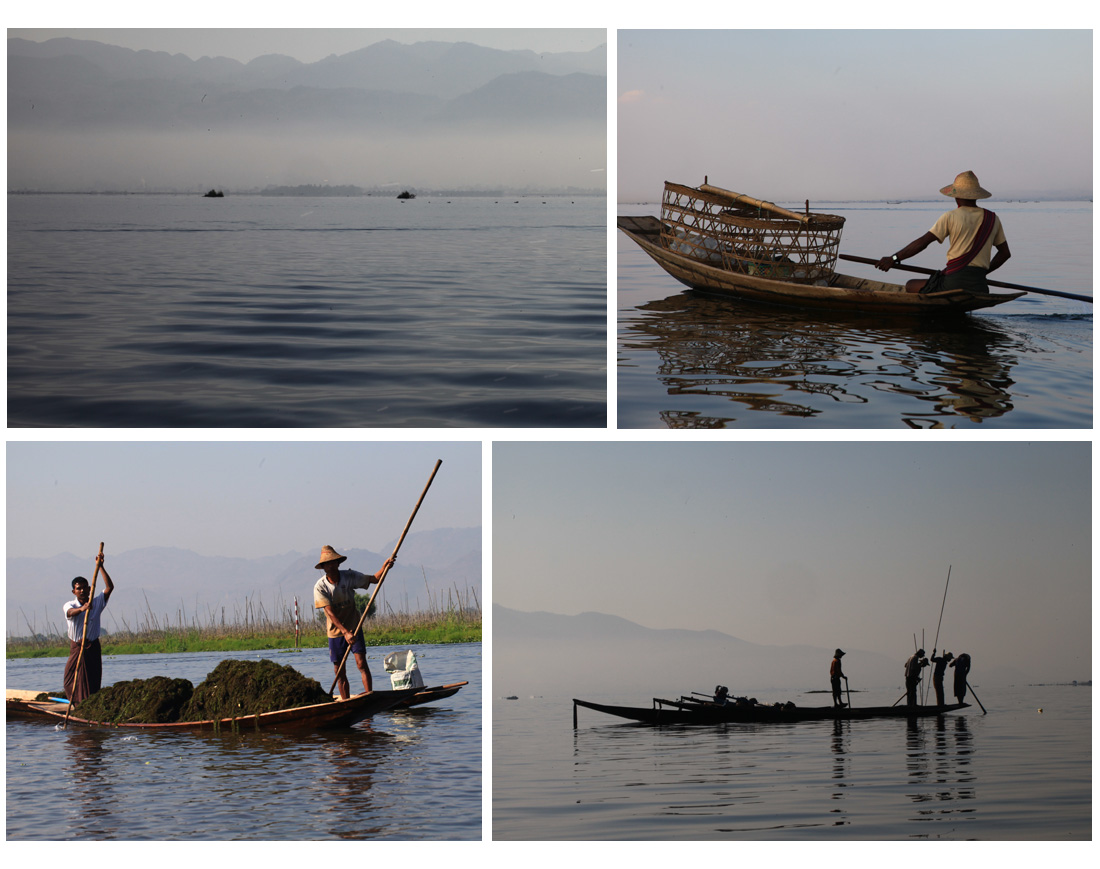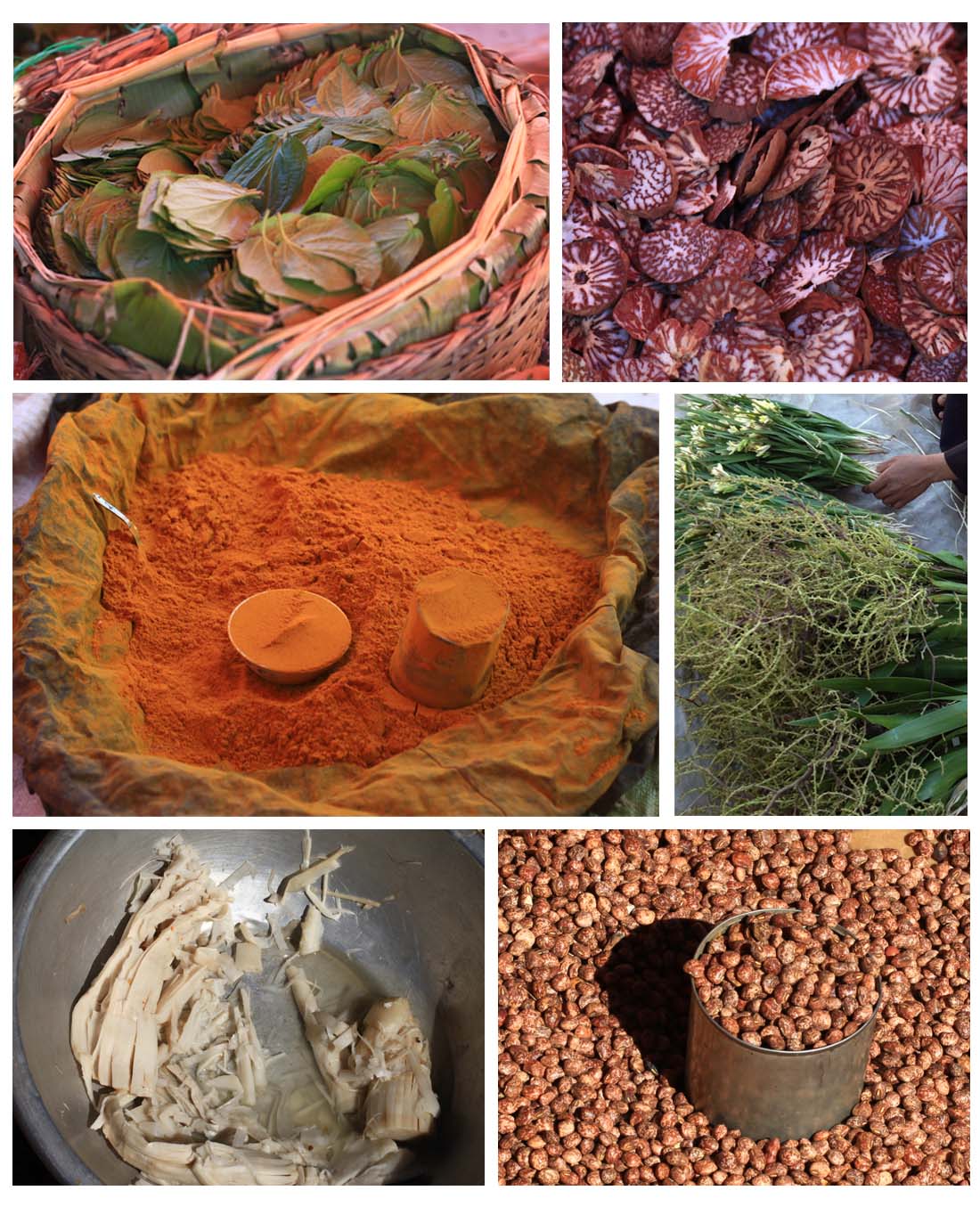Inle is an inland, freshwater lake, latitude 20.6N and longitude 95.9E in Burma (Myanmar). The lake and its shores are the home of many peoples and wildlife. In recent decades, the growing of vegetables on raised ‘floating’ beds has taken off and is spreading over the open water.
Here are some notes and images in a description of a visit to Inle in February 2014.

Floating gardens
To make the raised beds, soil is scraped from the lake bottom and piled to create long flattish ridges which rise in height under water and eventually emerge above the water-surface. The ridges are separated by long, thin inlets along which cultivators paddle boats to tend the gardens.
Organic matter in the form of water weed is dragged from the lake and piled on the ridges, bringing some cohesion to the wet soil and adding plant nutrients.The crops, mainly vegetables, have ample water and take additional nutrients from the lake. The gardens are anchored to the underlying soil and mud by long bamboo poles or straight tree-branches.

The gardens are made by the same principle and for similar reasons as the run-rigs of old Scottish agriculture. Where soil was too thin for crops, it was scoured from furrows and piled on ridges two or three metres wide. Organic matter, such as vegetation cut from surrounding uncultivated land or seaweed dragged from the shore, was then piled on the ridges. For ease of creation, using draught animals pulling ploughs, the ridges were long and thin.
The floating gardens of Inle look to be highly fertile, growing tomato, various melons and flowers. The produce finds a ready market in the country’s main cities.
Open water
The lake system, since there is more than one lake, is a major location for bird life and water animals. Below are photographs of the lake in the early morning. People are fishing or collecting water-weed to use as mulch or fertiliser.

Market
A market moves from point to point around the margin of the lake. It sells all the main types of staple food – cereals, legumes or pulses, vegetables – and many herbs and spices, medicinals, natural cosmetics for skin and hair, and things to drink or chew like betel. Most produce is raw or only slightly processed.The variety is immense, far greater than in any of our supermarkets and perhaps rivalled in Europe only by a few street markets in the east.

Images above: (top left to right) betel leaf in a bamboo basket lined with banana leaves, sliced betel nut; (mid) powdered turmeric (probably, but what a colour!), fresh leaf and flower; (bottom) bamboo shoots in a metal basin, ready to cook, and beans by the measure.
Natural fibre
The lake and its shores support a quality weaving trade: silk, cotton and coarser fibre, but the speciality is fibre taken from the lotus, a water-plant that looks like a huge water lily, with big leaves and the famous lotus flower. It’s the stems that reach up from the bottom of the lake to hold the leaves on the surface that contain the fibres. The stems have air ‘pipes’ running up and down their length and around these are the fibres which are extracted by hand from short cut lengths of stem. The whole process of harvesting, extracting the fibres, spinning them into threads and then weaving them into cloth is by hand and highly skilful. Lotus fibre fabric commands a very high price. Finery from mud through plants!

The images above show various natural fibres at a weaving business on Inle, the larger image, lower left, shows lotus fibre.
Knowledge of natural products
The impressive thing about Inle, and it’s much the same throughout Burma, is the immense and ever-present working knowledge of plants and other natural products. The technologies used to grow the crops and convert the raw materials might still be mostly manual, part-mechanised and small-scale, but the people doing all this understand the continuity of the process, from sowing seed to selling a product – knowledge and experience now lost from most of Europe.
The childhood memory of harvest festivals recalled a staid affair, sheaves brought in, but not so much joy. The Buddist thanksgiving we happened on one evening, and were invited to, was a happy and raucous event, based in the compound of a stupa, and centred on a massive wok of sticky rice, which was mixed with great vigour by men wielding three or four huge wooden stirrers. The dish, apart from the rice, includes peanuts Arachis hypogea, and coconut Cocos nucifera cut into ribbons, with perhaps some beans, and handed out with great friendliness to anyone who happened to be near. Rolled into balls and popped in the mouth – tasty it was and filling. All the time, a complex rhythm was beaten on an instrument consisting of several gongs hit mostly in unison, with cymbals adding a higher, coarser sound.
Sustainablity
The vegetables gardens of Inle are under the same pressures as agriculture everywhere. As markets open and sales rise, demand increases to bring more land under intense production and to get more from each square metre. Floating horticulture at Inle appears to have intensified at about the same time (from the mid-1900s) as growing crops with increasing fertiliser and pesticide spread through north-west Europe.
The extension of the gardens over a greater area of the open water, and the pressure to get more from each square metre, are inevitably affecting other aspects of the lake, such as its value as habitat for wildlife, a source of clean water for people and the money it brings through visitors.
The same questions can be asked therefore of Inle as of our local croplands: at which point will intensification begin to degrade the ecological life-support systems on which agriculture depends; and can a system be designed for managing land and water sustainably and for a range of purposes in the very long term. The answer to the first question is that degradation has begun in both places. The answer to the second is … yes, it could.
References
The interpreter and guide Ei Ei Linn introduced us to the floating gardens and explained the names and uses of many local plants and products.
The Wikipedia entry on Inle is informative but emphasises the negatives. The Lonely Planet guide has some information. For more detail, see also:
Sidle RC, Ziegler AD, Vogler JB. 2007. Sustainability Science 2, 55-65.
[GRS, 2014]
